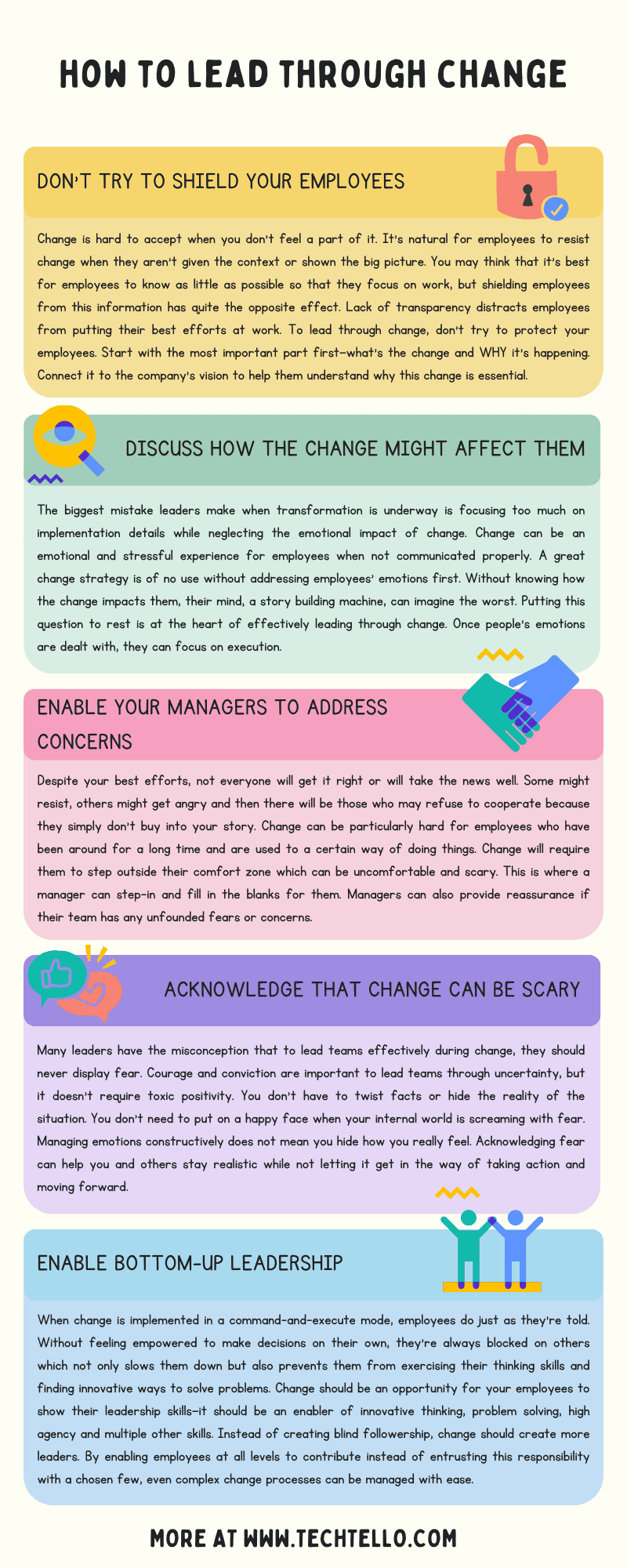How to Lead Through Change

Change is necessary to adapt, innovate and move ahead with the changing times. Organizations that don’t embrace change and stick to the status quo are often left behind.
Change is complex because there’s ambiguity, uncertainty and risk involved. Multiple moving factors, interdependencies and conflicting signals can make change very hard to implement.
When leading through change, leaders have to face many obstacles, but the biggest bottleneck isn’t the challenges along the way, it’s how change is presented and communicated to employees.
There’s too much focus on strategy, execution and operational excellence and too little on ensuring effective communication.
Communication which is the key driver of ensuring a smooth transition is mostly an afterthought.
Effectively leading through change requires a communication strategy—right information must be communicated at the right time. Sharing too much information can leave employees feeling overwhelmed and too little can lead to resistance and disengagement.
You can’t get employees buy-in by enforcing change. You can’t let them play a guessing game. To lead through change, you have to be on top of your communication game.
Here are the 5 strategies I have seen work extremely well to lead effectively through change:
Don’t try to shield your employees
Change is hard to accept when you don’t feel a part of it. It’s natural for employees to resist change when they aren’t given the context or shown the big picture.
You may think that it’s best for employees to know as little as possible so that they focus on work, but shielding employees from this information has quite the opposite effect. Lack of transparency distracts employees from putting their best efforts at work.
Leaving important details out has another problem. When change is not communicated properly, people try to fit the missing puzzle pieces together which is subject to bias, misinterpretation and false rumors.
You can’t communicate that some things are going to change and not expect employees to get curious about the details. They will try to find answers. They will try to seek clarity. Not getting it from authoritative sources can lead to miscommunication and confusion due to inconsistent messages from people who don’t have first hand knowledge of the change.
To lead through change, don’t try to protect your employees. They are mature enough to handle the truth when communicated properly.
Start with the most important part first—what’s the change and WHY it’s happening. Connect it to the company’s vision to help them understand why this change is essential.
Leadership requires two things: a vision of the world that does not yet exist and the ability to communicate it…People don’t buy WHAT you do, they buy WHY you do it.
— Simon Sinek, Start with Why
Once your employees understand the rationale behind it, it’s easier to get them on board and contribute to successfully executing the organization’s mission.
Discuss how the change might affect them
The biggest mistake leaders make when transformation is underway is focusing too much on implementation details while neglecting the emotional impact of change.
Change can be an emotional and stressful experience for employees when not communicated properly. A great change strategy is of no use without addressing employees’ emotions first.
When you lead people through difficult change, you take them on an emotional roller coaster because you are asking them to relinquish something—a belief, a value, a behavior—that they hold dear.
— Ronald A. Heifetz, Leadership on the Line
The emotional toll will be different for each individual depending on how they process the news, but what drives this inner experience is the question that bothers them the most “how will this change impact me?”
Without knowing how the change impacts them, their mind, a story building machine, can imagine the worst:
I’ll be fired.
My project will be discontinued.
I won’t be promoted.
I won’t get my bonus.
Left unanswered, this nagging question can lead to overthinking often to the point of rumination which can take a toll on their mental health and personal well-being.
Putting this question to rest is at the heart of effectively leading through change. Once people’s emotions are dealt with, they can focus on execution.
Here are some common questions to address:
- What are the expected changes?
- Why are these changes happening?
- When will the change be implemented?
- Who is affected by the change and how?
- Will this change impact their day-to-day responsibilities?
- Who can give them more clarity?
The last question is very important. Don’t assume your employees have understood everything or that they’re ready to jump on the bandwagon. They will have plenty of questions—a lot of things that they would want answered before you can expect them to be wholeheartedly involved.
Enable your managers to address concerns
Despite your best efforts, not everyone will get it right or will take the news well. Some might resist, others might get angry and then there will be those who may refuse to cooperate because they simply don’t buy into your story.
Change can be particularly hard for employees who have been around for a long time and are used to a certain way of doing things. Change will require them to step outside their comfort zone which can be uncomfortable and scary.
This is where a manager can step-in and fill in the blanks for them. Managers can also provide reassurance if their team has any unfounded fears or concerns.
Ensure your managers have the visibility needed to address their team’s concerns. Coach them to be respectful of others emotions and not disregard how people feel. Give them the resources, information and guidance needed to have effective conversations. They might have their own concerns about the change. So, make sure you address them first. Your managers can’t convince their team if they have their own doubts about the change.
This is what every manager in the organization must do to help lead through change:
- Setup 1:1s with the direct reports to check how they’re coping with the change and what kind of support they may need.
- Try to uncover areas that might be concerning or potentially bothering them.
- Acknowledge their contribution to the growth of the organization. This is particularly useful for old-timers who might be worried that the organization does not value them anymore.
- Invite them to be part of the change. Discuss their role, how they can help and brainstorm together on possible solutions. Challenge their creativity and thinking skills—feeling that they are part of the decision making process will go a long way in instilling a sense of ownership and accountability.
Bringing more visibility around change will be an on-going process. Keeping your teams apprised with the latest developments will require continuous communication and dialogue.
Acknowledge that change can be scary
Many leaders have the misconception that to lead teams effectively during change, they should never display fear. Courage and conviction are important to lead teams through uncertainty, but it doesn’t require toxic positivity.
You don’t have to twist facts or hide the reality of the situation. You don’t need to put on a happy face when your internal world is screaming with fear.
Managing emotions constructively does not mean you hide how you really feel. Acknowledging fear can help you and others stay realistic while not letting it get in the way of taking action and moving forward.
Rather, by accepting that change can be scary, leaders can:
- Turn fear into a motivating factor to embrace challenges and unknowns.
- Use it as a sign that they’re doing something worthwhile.
- Reappraise anxiety into excitement to perform better. Research shows that reappraising anxiety as excitement can result in enthusiasm and better performance in subsequent tasks.
Remember that freedom from fear doesn’t mean the absence of its existence, but the refusal to let it control your decisions and actions.
— Joyce Meyer, Do It Afraid
By reframing fear as a thing to embrace instead of a thing to avoid, leaders can stay authentic and build meaningful connections with their teams by showing they’re human without letting fear get in the way of their success.
Enable bottom-up leadership instead of taking a top-down approach
When change is implemented in a command-and-execute mode, employees do just as they’re told.
When things don’t work out as expected or results don’t match their expectations, instead of course correcting by changing strategy or implementing new tactics, they wait for people from the top to tell them what to do next.
Without feeling empowered to make decisions on their own, they’re always blocked on others which not only slows them down but also prevents them from exercising their thinking skills and finding innovative ways to solve problems.
Change should be an opportunity for your employees to show their leadership skills—it should be an enabler of innovative thinking, problem solving, high agency and multiple other skills.
Instead of creating blind followership, change should create more leaders. By enabling employees at all levels to contribute instead of entrusting this responsibility with a chosen few, even complex change processes can be managed with ease.
To do this:
- Clearly communicate to your employees what kind of decisions they can make on their own and in what kind of decisions their manager or other leaders of the organization should be involved.
- Encourage them to experiment, fail and adapt. Iteratively learning from failures and putting corrections in place is the best way to successfully implement any change.
- Make it safe for employees to ask questions, express disagreement and raise their concerns. Leaders should not only say this in words, but also demonstrate it in their actions.
By using change as a catalyst for innovation, creativity and developing thinking skills, leaders can energize their teams to step outside their comfort zones and contribute to the success of the organization while also expanding their own leadership skills—a true win/win.
Summary
- Change in any organization is inevitable. Organizations that take conscious steps to adapt to the changing times stick around while others usually die.
- The biggest challenge to successfully implement any change isn’t coming up with a solid strategy or an extensive execution plan—though those things are important in their own ways—it’s how the change is communicated to employees.
- Keeping important information away from employees as a measure to protect them usually backfires. Not having the answers distracts them from putting their time and energy into work. Instead of trying to shield them, share the context and give them clarity. Connect the change to the organization’s vision. Knowing the “why” of doing something is a powerful motivating factor.
- Every change is an emotional experience for employees. Not knowing how the change impacts them can lead to stress and anxiety. Addressing how the change impacts their day-to-day work or responsibilities or what might it mean for them is crucial to lead effectively through change.
- Keeping communication lines open with all employees is essential to lead through change. Despite your best efforts, not everyone may approve of your plan. This is where managers can step-in. They can work closely with their team members to address their worries and concerns.
- When you’re doing something worthwhile, fear naturally comes along for the ride. Instead of hiding that change is scary, leaders can use it as a powerful motivating factor. Acknowledge it without letting it get in the way of your decisions or how you move forward.
- Change is a great opportunity for your employees to put their thinking, problem solving and leadership skills to test. Promote bottom-up leadership by empowering your employees through the entire change process.






























